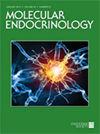GHR/PRLR Heteromultimer Is Composed of GHR Homodimers and PRLR Homodimers.
Q Biochemistry, Genetics and Molecular Biology
引用次数: 13
Abstract
GH receptor (GHR) and prolactin (PRL) receptor (PRLR) are homologous transmembrane cytokine receptors. Each prehomodimerizes and ligand binding activates Janus Kinase 2 (JAK2)-signal transducer and activator of transcription (STAT) signaling pathways by inducing conformational changes within receptor homodimers. In humans, GHR is activated by GH, whereas PRLR is activated by both GH and PRL. We previously devised a split luciferase complementation assay, in which 1 receptor is fused to an N-terminal luciferase (Nluc) fragment, and the other receptor is fused to a C-terminal luciferase (Cluc) fragment. When receptors approximate, luciferase activity (complementation) results. Using this assay, we reported ligand-independent GHR-GHR complementation and GH-induced complementation changes characterized by acute augmentation above basal signal, consistent with induction of conformational changes that bring GHR cytoplasmic tails closer. We also demonstrated association between GHR and PRLR in T47D human breast cancer cells by coimmunoprecipitation, suggesting that, in addition to forming homodimers, these receptors form hetero-assemblages with functional consequences. We now extend these analyses to examine basal and ligand-induced complementation of coexpressed PRLR-Nluc and PRLR-Cluc chimeras and coexpressed GHR-Nluc and PRLR-Cluc chimeras. We find that PRLR-PRLR and GHR-PRLR form specifically interacting ligand-independent assemblages and that either GH or PRL augments PRLR-PRLR complementation, much like the GH-induced changes in GHR-GHR dimers. However, in contrast to the complementation patterns for GHR-GHR or PRLR-PRLR homomers, both GH and PRL caused decline in luciferase activity for GHR-PRLR heteromers. These and other data suggest that GHR and PRLR associate in complexes comprised of GHR-GHR/PRLR-PRLR heteromers consisting of GHR homodimers and PRLR homodimers, rather than GHR-PRLR heterodimers.GHR/PRLR异聚体由GHR同二聚体和PRLR同二聚体组成。
GH受体(GHR)和催乳素受体(PRL)是同源的跨膜细胞因子受体。每个前二聚体和配体结合激活Janus激酶2 (JAK2)-信号转换器和转录激活因子(STAT)信号通路通过诱导受体内的构象变化。在人类中,GHR由生长激素激活,而PRLR由生长激素和PRL共同激活。我们之前设计了一种分裂荧光素酶互补试验,其中1个受体融合到n端荧光素酶(Nluc)片段,另一个受体融合到c端荧光素酶(Cluc)片段。当受体接近时,荧光素酶活性(互补)产生。通过该实验,我们报道了不依赖配体的GHR-GHR互补和gh诱导的互补变化,其特征是基础信号的急性增强,与诱导GHR细胞质尾部更近的构象变化一致。我们还通过共免疫沉淀证明了T47D人乳腺癌细胞中GHR和PRLR之间的关联,这表明除了形成同型二聚体外,这些受体还形成具有功能后果的异质组合。我们现在将这些分析扩展到研究共表达PRLR-Nluc和PRLR-Cluc嵌合体以及共表达GHR-Nluc和PRLR-Cluc嵌合体的基础互补和配体诱导互补。我们发现PRLR-PRLR和GHR-PRLR形成特异性的不依赖于配体的相互作用组合,GH或PRL增强了PRLR-PRLR的互补,就像GH诱导的GHR-GHR二聚体的变化一样。然而,与GHR-GHR或PRLR-PRLR异构体的互补模式相反,GH和PRL都导致GHR-PRLR异构体荧光素酶活性下降。这些数据和其他数据表明,GHR和PRLR在由GHR同二聚体和PRLR同二聚体组成的GHR-GHR/PRLR-PRLR异聚体复合物中结合,而不是GHR-PRLR异二聚体。
本文章由计算机程序翻译,如有差异,请以英文原文为准。
求助全文
约1分钟内获得全文
求助全文
来源期刊

Molecular endocrinology
医学-内分泌学与代谢
CiteScore
3.49
自引率
0.00%
发文量
0
审稿时长
12 months
期刊介绍:
Molecular Endocrinology provides a forum for papers devoted to describing molecular mechanisms by which hormones and related compounds regulate function. It has quickly achieved a reputation as a high visibility journal with very rapid communication of cutting edge science: the average turnaround time is 28 days from manuscript receipt to first decision, and accepted manuscripts are published online within a week through Rapid Electronic Publication. In the 2008 Journal Citation Report, Molecular Endocrinology is ranked 16th out of 93 journals in the Endocrinology and Metabolism category, with an Impact Factor of 5.389.
 求助内容:
求助内容: 应助结果提醒方式:
应助结果提醒方式:


